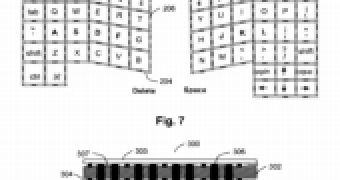Apple is really in love with its multi touch interface technology. If it wasn't very clear from Steve Job's frustration that people just don't understand how big a step forward it is, it is perfectly clear in a patent filing that has recently surfaced. The paper describes various methods in which once could give physical feedback on a touch sensitive keyboard, without interfering with gestures in any way.
Originally applied for last April, the US Patent Office application explains the difficulties faced by makers of touch sensitive controls. For more complex interfaces that require swipes and multiple finger gestures, a perfectly flat surface is desirable; however, this will force users into having to readjust. Alternatively, the manufacturer may compromise it by adding slight bumps and ridges on the keyboard, but these will limit the amount of control possible, resulting in a device that is neither a good keyboard nor a good touch sensitive interface but a bad mix of the two. "For example, the key-edge ridges impede lateral pointing motions, giving the surface a rough washboard feel. The ridges also disrupt position interpolation from capacitive sensor arrays as the fingertip flesh lifts over the ridge."
Apple inventor Wayne Carl Westerman offers multiple solutions to this problem. The simplest is just applied common sense, and would see ridges, dots or symbols in the locations where they would make the most sense, such as the typing home row. The second consists of an articulating frame underneath the keyboard, which would change the surface depending on the current context. Thus, in typing mode, the frame could raise to create edges between virtual keys, provide haptic (vibration) feedback, or create concavities that act like the dips in a traditional keyboard.
Last but not least, the third method would see a static frame and fill an area under the touch surface. This would be an easily deformable material such as foam, gel, or even air. The resistance of this frame would be enough to keep the surface flat when making gestures with only light pressure, but would allow for sinking on hard presses such as when typing or deliberately pressing.
The patent application doesn't mention any other Apple products, which is a bit unusual for Apple. While this is intimately linked to the multi touch technology used in the iPhone, it would not really be good for any device whose input surface is also its screen.

 14 DAY TRIAL //
14 DAY TRIAL //